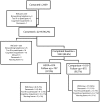Primary prevention of falls: effectiveness of a statewide program
- PMID: 24625164
- PMCID: PMC3987590
- DOI: 10.2105/AJPH.2013.301829
Primary prevention of falls: effectiveness of a statewide program
Abstract
Objectives: We examined a population-wide program, Pennsylvania's Healthy Steps for Older Adults (HSOA), designed to reduce the incidence of falls among older adults. Older adults completing HSOA are screened and educated regarding fall risk, and those identified as being at high risk are referred to primary care providers and home safety resources.
Methods: From 2010 to 2011, older adults who completed HSOA at various senior center sites (n = 814) and a comparison group of older adults from the same sites who did not complete the program (n = 1019) were recruited and followed monthly. Although participants were not randomly allocated to study conditions, the 2 groups did not differ in fall risk at baseline or attrition. We used a telephone interactive voice response system to ascertain the number of falls that occurred each month.
Results: In multivariate models, adjusted fall incidence rate ratios (IRRs) were lower in the HSOA group than in the comparison group for both total (IRR = 0.83; 95% confidence interval [CI] = 0.72, 0.96) and activity-adjusted (IRR = 0.81; 95% CI = 0.70, 0.93) months of follow-up.
Conclusions: Use of existing aging services in primary prevention of falls is feasible, resulting in a 17% reduction in our sample in the rate of falls over the follow-up period.
Figures


References
-
- National Council on Aging. Standing together to prevent falls. Available at: http://www.ncoa.org/calendar-of-events/webinars/standing-together-to-pre.... Accessed January 15, 2014.
-
- Centers for Disease Control and Prevention. WISQARS. Available at: http://www.cdc.gov/injury/wisqars/index.html. Accessed January 15, 2014.
-
- Gillespie LD, Robertson MC, Gillespie WJ et al. Interventions for preventing falls in older people living in the community. Cochrane Database Syst Rev. 2009;2:CD007146. - PubMed
-
- King MB. Falls. In: Halter JB, Ouslander JG, Tinetti ME, Studenski S, High KP, Asthana S, editors. Hazzard’s Geriatric Medicine and Gerontology. New York, NY: McGraw Hill; 2009. pp. 659–670.
Publication types
MeSH terms
Grants and funding
LinkOut - more resources
Full Text Sources
Other Literature Sources
Medical

